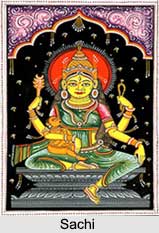 Sachi is the Queen of Lord Indra. Sachi is believed to be the Goddess of Wrath and jealousy. She is connected with lions and elephants. Sachi or Indrani is described as being very beautiful and attractive and had one-thousand eyes. Initially, she was not held to be in high-esteem, as she was born to Puloman. Puloman was a demon who was killed by Indra. Sachi is also believed to be one of the Sapta Matrikas or the mother goddesses.
Sachi is the Queen of Lord Indra. Sachi is believed to be the Goddess of Wrath and jealousy. She is connected with lions and elephants. Sachi or Indrani is described as being very beautiful and attractive and had one-thousand eyes. Initially, she was not held to be in high-esteem, as she was born to Puloman. Puloman was a demon who was killed by Indra. Sachi is also believed to be one of the Sapta Matrikas or the mother goddesses.
Different Names of Sachi
In the Hindu mythology, Indrani is also known by many other names, Sachi being the most famous of them. Sachi is said to denote Shakti, the power and Indrani is considered a powerful divine being. She is also called by the names Aindri, Mahendri, Pulomaja and Poulomi.
Marriage of Sachi with Lord Indra
Sachi was the daughter of a demon named Puloman. Once, Sachi was carried off by Lord Indra. Soon, she fell in love with Indra and married him. She then became a Goddess and was called Indrani, the Queen of Indra. Lord Indra then granted her immortality.
Descendants of Sachi
Lord Indra and Sachi had many sons named Jayanta, Midhusa, Nilambara, Rbhus, Rsabha and Kambha. They had two daughters named Jayanti and Devasena.
Legends of Sachi
Once Lord Indra had to flee from his kingdom and hid elsewhere on account of his sin of killing a Brahmin. King Nahusha seized power and began ruling the heavens, became arrogant and developed a strong desire for possessing Indrani. Alone and helpless, she sought refuge from some sages, who advised her of a plan to end Nahusha"s tyranny and restore the heavens to her husband. Accordingly, she told Nahusha to come to her in a special palanquin carried by the great sages. Nahusha did so immediately. When the short heighted Sage Agasthya could not move fast carrying the palanquin, Nahusha touched the great sage with his feet and forced him to proceed quickly, with the words "Sarpa, Sarpa". Sage Agasthya cursed the impertinent king to become "Sarpa", a serpent. Nahusha turned into a snake at once and fell down from the heaven. Indra too completed his atonement for the sin, got back to his dear wife and also obtained the kingship of heavens.









